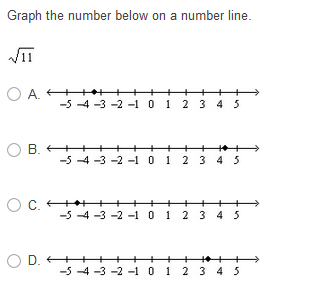Can someone help me please? Thanks!

2 Answers
A. Though a case could be made for D since the markings are a little vague.
Explanation:
The easiest way that I know of to find the answer to this kind of question without a calculator is to think logically.
This eliminates B and C.
Because a square root can be either positive or negative, we must consider both of the remaining options.
To narrow it down some more lets look at the closest perfect square less than
The square root of
Now it starts to get a little more involved, but I'm sure you can handle it.
Because the difference between
Why? If
We can also guess that the answer will be about
Naturally you could always skip straight to that step, but I wanted to make sure you understood the process.
To finally find your answer, look for the option that appears closest to
This method has some flaws, and I went into way more detail than you really needed, but it will get the job done.
Just remember to Be Careful, Think Logically, and Use a Calculator when you can.
I really hope this makes sense. I promise it's really simple even though I took forever to explain it.
D
Explanation:
Here's a geometric solution...
-
Start with the points
#(0, -1)# and#(0, 11)# -
Find their midpoint
#(0, 5)# -
Draw a circle with centre
#(0, 5)# passing through#(0, -1)# and#(0, 11)# -
The points where this circle intersects the
#x# axis are#(+-sqrt(11), 0)#
graph{(x^2+(y-5)^2-36)((x+sqrt(11))^2+y^2-0.01)((x-sqrt(11))^2+y^2-0.01)(x^2+(y-5)^2-0.01) = 0 [-14, 14, -2, 12]}
So the answer is D
This construction works because the triangles:
#(0, 0), (-1, 0), (sqrt(11), 0)#
#(0, 0), (sqrt(11), 0), (0, 11)#
must be similar to one another.


